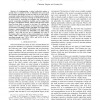Free Online Productivity Tools
i2Speak
i2Symbol
i2OCR
iTex2Img
iWeb2Print
iWeb2Shot
i2Type
iPdf2Split
iPdf2Merge
i2Bopomofo
i2Arabic
i2Style
i2Image
i2PDF
iLatex2Rtf
Sci2ools
ICRA
2008
IEEE
2008
IEEE
Storing and recalling information for vision localization
— In implementing a vision localization system, a crucial issue to consider is how to efficiently store and recall the necessary information so that the robot is not only able to accurately localize itself, but does so in a timely manner. In the presented system, we discuss a strategy to minimize the amount of stored data by analyzing the strengths and weaknesses of several cooperating recognition modules, and by using them through a prioritization scheme, which orders the data entries from the most likely to match to the least. We validate the system is a series of experiments at three large scale outdoor environments: a building complex (126x180ft. area, 3583 testing images), a vegetation-filled park (270x360ft. area, 6006 testing images), and an open-field area (450x585ft. area, 8823 testing images) - each with its own set of challenges. Not only is the system able to localize in these environments (on average 3.46ft., 6.55ft. 12.96ft. of error, respectively), it does so while ...
| Added | 30 May 2010 |
| Updated | 30 May 2010 |
| Type | Conference |
| Year | 2008 |
| Where | ICRA |
| Authors | Christian Siagian, Laurent Itti |
Comments (0)

